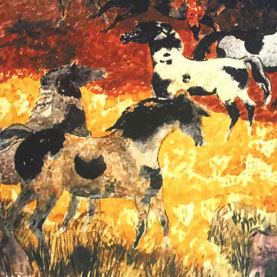Past Exhibition
MILLARD SHEETS: Hills and Horses
Sunday, November 1 at the Padua Hills Art Fiesta
Padua Hills Theatre, 4467 Padua Ave., Claremont, 11 a.m.- 4 p.m. Art Fiesta tickets are $8 for adults, $6 for CMA members. Children under 18 are free.
November 4–February 28, 2016 at Rancho Santa Ana Botanic Garden
1500 N. College Ave., Claremont. Exhibition is open Daily 10 a.m.-4 p.m.
Garden admission is $8 for adults, $6 for seniors and students, $4 for children and free for CMA and RSABG members.
Inspired by a lifelong love of horses and the landscape surrounding his Padua Hills home, artist Millard Sheets depicted a familiar way of life. The exhibition Millard Sheets: Hills and Horses, curated by his son Tony Sheets, will include paintings, drawings and lithographs from the years that he lived in Padua Hills in the 1940s-60s and beyond. The exhibition is sponsored by Claremont Eye Associates, Maria (Zornes) and Hal Baker, Tony and Flower Sheets, and by Tom & Carolyn Sheets Owen-Towle.
Millard came to Claremont in 1930 to develop the fledgling art department at Scripps College and form the Graduate art program. Under his leadership, Claremont became a significant artistic center. Wanting to raise his children in the country, he purchased ten acres in the Padua Hills where so many of his artist friends lived.
As his daughter Carolyn Owen-Towle recalls in her book Damgorgeous, “Millard promptly built an enormous barn to house his thirteen horses. He built a small corral and a large paddock with an eighth mile track around it. In those days he was racing trotters at the County Fair. In 1941, just before the war began to escalate rapidly, Mary and Millard broke ground for their dream home on the hilltop of their property. Millard designed a rammed-earth dwelling with split levels, a fourteen foot flat-roofed ceiling, and floor to ceiling windows in the living room. The house had an intimate, commanding view of the San Gabriel Mountains.”
Throughout a long and prolific career, Millard Sheets was at once a painter, a muralist, an architectural designer, a teacher and art administrator, an entrepreneur, and an inspired cheerleader who tirelessly preached the importance of art in daily life. Handsome and energetic, daring and resourceful, he was a passionate ambassador for the arts.
About the Artist
Born in 1907 on a ranch in Pomona, Millard Sheets showed early promise as an artist and attended Chouinard Art Institute in Los Angeles. There he became accomplished in many media – painting, printmaking, mural painting and architectural design. An early trip to Europe introduced him to German Expressionism and Turner’s watercolors. His interest in Regionalism produced paintings of rural California as well as scenes of Los Angeles in the Depression. In 1930 he arrived to develop the fledgling art department at Scripps College and form the Graduate art program. Under his leadership, Claremont became a significant artistic center. He built his house in the Padua Hills where so many of his artist friends lived.
The war years saw him designing flight-training schools and working as an artist-correspondent for Life magazine where he painted many scenes of India and Burma. After the war he returned to Scripps and the Claremont Graduate School to mentor returning GIs in their art careers. Many of these young men and women were drawn to the Abstract Expressionism and while it was not Sheet’s preferred style he encouraged them. Sheets was put in charge of the Fine Arts program at the L.A. County Fair in the early fifties and his students were put to work preparing the galleries and often being shown there. In 1953 Sheet’s became the director of the new Otis Art Institute in Los Angeles but he maintained his studio in Claremont. Here he designed many of the Home Federal Savings Banks with their stunning mosaic murals and worked with many architects on other projects. He retired to northern California where he died in 1989.
Gallery

